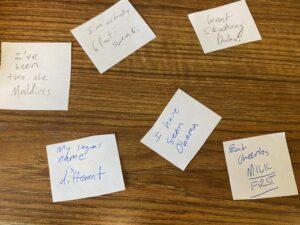Our game, “I Swear,” is very similar in some ways to “Two Truths and a Lie”. Both games are deduction games, and require players to discern what is a truth and what is a lie among what players say. For this Critical Play, I will be analyzing a game of “Two Truths and a Lie!”
The game pits one player against all the others in the group, and most players need to cooperatively work together to discern which of the three statements communicated by the remaining player is a lie. As such, the game introduces social team-based co-op elements with players talking amongst themselves and trying to perform deduction. The adversarial nature between the two sides is also preserved in our version of the game which we played, where other players can ask clarifying questions on the possible truths and lies, to try and poke holes into the “fact-supporting stories”. This made the game especially fun for us, as when someone was indeed lying, they had to cook up convincing auxiliary lies which at times began sounding absolutely absurd and ridiculous, making everyone laugh on repeated occasions.
This game introduced elements of fun from the co-operation and competition that the game mechanics fostered. Players could theoretically just vote immediately after hearing the possible options for truths and lies, but it is the discussion and the back and forth conversations where most of the fun lies.
Besides players themselves voicing their opinions on the content being discussed in the game, the game doesn’t really have any structures in place to handle abuse in the form of bringing up content not all players are comfortable with. For example, players could overshare about aspects of their life or think of very vulgar lies that other players are not comfortable with hearing. This would then breach through the boundaries of what is still considered fun for the players, and cause the game to no longer be a safe, enjoyable experience for all.
Abuse seems to be handled through a sort of community moderation. If players take an action that breaches the social contract signed among them before they begin playing, then it comes down to those players to step in and prevent further abuse from taking place. However, this can become tough in practice, for example when the players are too unfamiliar with each other to know to feel comfortable speaking up, or if a certain power dynamic exists among players prior to the game beginning.
If I were to modify the game, I would add a time limit for each of the players’ rounds. Otherwise, what we saw happening was that certain players had much more time spent on their questions than with other players, which made the gameplay slightly inequitable for all those playing.
Compared to other deduction games, Two Truths and a Lie is such a simple game to play that it is truly versatile and can be played almost anywhere. Any physical gameplay objects, like cards to write the truths and lies on, are strictly optional, a lot of fun can be had without them. This sets apart this game from others in its genre, as its simplicity/fun ratio is simply unmatched.



